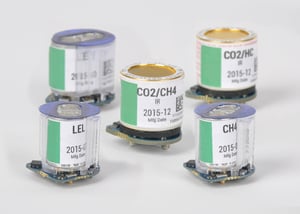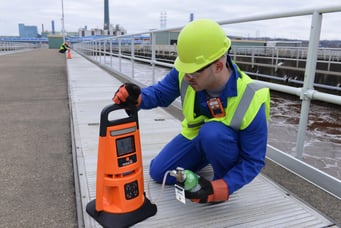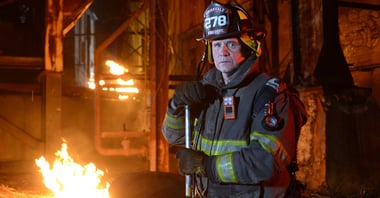Not all carbon monoxide sensors are the same. Carbon monoxide (CO) sensors are found in gas detectors used by workers conducting their jobs in environments where toxic CO gas might be present. CO can be found in almost any industry and poses a big threat, since it’s a result of incomplete combustion. Luckily, there are many different types of CO sensors. If you understand the different types, advantages and disadvantages of each, you’re able to select the proper CO sensor for your application. There are three things to consider when choosing a CO sensor – your application, your CO gas levels, and the potential cross-interfering gases that could be present.
Types of CO Sensors
If you’ve been in the market for a gas detector that monitors for CO, you’ve probably come across the following CO sensor names: CO, CO high, COSH, CO/H2 low, and CO/H2 null. What’s the difference?
- The standard CO sensor is the most commonly used CO sensor type. While it measures CO and usually includes a hydrogen sulfide (H2S) filter to eliminate H2S cross-interference, it is susceptible to cross-interference from other gases, most notably hydrogen (H2). When using this standard sensor, you should consider if there could be other gases present that might interfere with the sensor’s readings. You should also consider is the sensor’s measuring range. A standard CO sensor measures up to 1,000 or 1,500 ppm (parts per million), which might not be sufficient for all applications and industries, such as mine rescue applications or the steel industry.
- The CO high or CO high range sensor is commonly used in specific industries such as mining/mine rescue and steel. Rather than the typical measuring range of 1,000 or 1,500 ppm, this sensor is capable of measuring carbon monoxide up to concentrations of 9,999 ppm. When facilities have processes that give off high concentrations of CO and workers perform operations under supplied air, these sensors are often the sensor of choice.
- The CO/H2 low sensor and CO/H2 null sensor are each designed to reduce the cross-interference of H2. These terms are often used interchangeably, but they are in fact different. CO/H2 low or CO/H2 null sensors are commonly used in steel mills and power plants.
- The CO/H2 low sensor achieves this reduced cross-interference of hydrogen using two electrodes and a special catalyst with a lower sensitivity to hydrogen.
- The CO/H2 null sensor uses four electrodes, and it is actually a combination sensor (similar to the COSH sensor). It includes one sensing electrode dedicated to detecting CO and a second sensing electrode dedicated to detecting H2. The CO/H2 null sensor measures both the CO and H2 gas concentrations separately, and then subtracts the H2 gas reading from the CO gas reading.
- The COSH sensor, otherwise known as CO/H2S, is commonly used to detect for CO. This sensor is a combination of a carbon monoxide sensor plus a hydrogen sulfide sensor, with both sensors being built into a single housing. This sensor includes one sensing electrode dedicated to detecting carbon monoxide and a second sensing electrode dedicated to detecting hydrogen sulfide. These sensors are commonly used to detect gases using multiple sensor slots. While sensing multiple gases can be extremely convenient in smaller size gas detectors, remember that since this sensor must allow both gases to diffuse into it, it will not include the H2S filter. The H2S filter is included in other CO sensors mentioned above. In the use of this sensor, there is a trade-off between gas detector size and the sensor’s cross-sensitivity to hydrogen sulfide.
Measuring for Carbon Monoxide with Different Sensors
It is critical that in environments where significant levels of hydrogen are present, you measure for CO using either a CO/H2 low or CO/H2 null sensor. Why is this important? Let’s do the math: If a CO sensor that is not a CO/H2 low or CO/H2 null sensor is exposed to 100 ppm of H2, the sensor would interpret the 100 ppm of H2 as 22 ppm of CO. This is based on the CO sensor’s cross-sensitivity to H2.
A CO/H2 low sensor typically has 5% or less H2 gas cross-interference. Re
ferring to the example above, a standard CO sensor would interpret and display 22 ppm of CO if 100 ppm of H2 was present in the environment. A CO/H2 low sensor with 5% or less H2 gas cross-interference would display 5 ppm or less of CO if 100 ppm of H2 was present in the environment.

The CO/H2 null sensor does its best to completely nullify the effect of H2 on the CO sensor. In practice, a CO/H2 null sensor will typically have 1% or less H2 cross-interference. Going back to the example again, a standard CO sensor exposed to 100 ppm H2 would interpret it as 22 ppm CO. A CO/H2 low sensor exposed to 100 ppm H2 would interpret it as and display 5 ppm or less CO. The CO/H2 null sensor exposed to 100 ppm H2 would interpret it as and display 1 ppm or less CO.
Clearly, for environments with high H2 concentrations, both the CO/H2 low and CO/H2 null sensors can help you avoid false alarms and provide an increased level of confidence that the CO reading being displayed has not been compromised by background H2 gas levels.
Using the Correct Sensors for Your Application
Now that you understand the differences between the different kinds of CO sensors, you might be wondering: What if I’m using the wrong CO sensor and if so, what is the risk? If your CO sensor is not best suited to your work environment, you might have insufficient data regarding potential exposure levels. You and your coworkers can become ill if you’re working in a dangerous environment with high, inaccurate or undetermined gas levels. False alarms from cross-interfering gases can cause workers to lose confidence in the gas readings, so they may continue to work in areas without the proper personal protective equipment or not evacuate the area when needed.
Although there is no doubt that sensors are complex and it can be challenging to select the right one, arming yourself with a better understanding of the different types of CO sensors can help. If you’re still in doubt about which CO sensor to use, talk to one of our experts for more info or download our guide to help take the guesswork out of gas detection.




